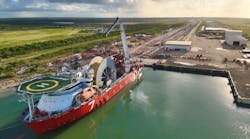Bruce Beaubouef
Managing Editor
Since 1864, Det Norske Veritas (DNV) has evolved from a Norwegian classification society into an international provider of classification and technical assurance along with software and independent expert advisory services to the maritime, oil and gas, and energy industries. In September 2013, DNV and German classification company Germanischer Lloyd (GL) merged to become DNV GL Group. Headquarted in Høvik, Norway, the company consists of more than 17,000 employees in more than 100 countries.
GL Noble Denton and DNV's Oil & Gas business joined forces to become the world's largest ship and offshore classification society and a technical assurance and risk management services provider to the oil and gas industry. It also became one of the top three management system certification bodies in the world. DNV GL Oil & Gas consists of more than 5,500 employess that combine industry expertise, multi-disciplinary skills, and innovation to solve complex challenges, develop best practices and standards across the asset lifecycle.
In January 2014, Elisabeth Tørstad was appointed CEO of DNV GL Oil & Gas. Based in Norway, she is also part of the Executive Committee for the DNV GL Group. Tørstad has two decades in management positions at legacy DNV, and was previously chief technology officer of DNV GL. Her academic background includes a Cand Scient degree from the University of Oslo and a degree of Business Administration from the Norwegian School of Management.
Recently,Offshore met with Tørstad to discuss the company's achievements, joint industry projects, and technical challenges facing the industry.
•••
Offshore: In October, you celebrated 150 years. How has DNV GL's business changed over time? How do you think it will change in the future?
Tørstad: The origin of DNV GL was to ensure safety at sea through an 'enabling role' in the development of the shipping industry. This has expanded into safe and reliable operations of oil and gas facilities and has advanced further into enabling a transition to a low carbon energy future.
Our core purpose is to have an impact on delivering a safe and sustainable future with safer, smarter, and greener strategies at the core of our business offering. This is what we will continue to strive toward - all with the aim of better serving our customers, industries, and ultimately society at large.
Offshore: Why has DNV GL expanded its role beyond that of a classification society?
Tørstad: As a classification society, our number one priority has been and remains to be about improving safety and business performance. This is in essence about managing risk, and with our technical competence and purpose to safeguard life, property, and the environment. Moving into other industries such as oil and gas and energy was a natural step. Oil and gas is an important business area for DNV GL, accounting for the second largest in the group's turnover after maritime.
Offshore: The 'great crew change' gets a lot of discussion. Does DNV GL address this? If so, how? Is it the biggest hurdle to safety offshore? If not, what is?
Tørstad: With the current low oil price, the short-term skills pressure in the industry may have abated for many, but the problem will persist in the long term if we do not take heed of lessons learned from previous downturns. In our fifth annual industry outlook report, "A Balancing Act: The outlook for the oil and gas industry in 2015," 'skills shortages' has been listed as the biggest barrier to growth for the last two years, now it has dropped nine places. These findings were based on a global survey of more than 360 senior industry professionals and executives.
We have provided assistance across the energy industry with company's formal programs to capture knowledge and expertise before subject matter experts retire. We have also developed many processes to embrace new ways of working and created new strategies and initiatives for training and development. Our internal Knowledge Portal helps us capture and share verified knowledge and includes key documents, showcases projects, and also lists key experts so that knowledge is transferred easily around the business worldwide and across our various sectors. Increasing diversity in the industry with regards to age, gender, mother tongue, culture, and nationality also drives a need for increasing formalization in capturing and transferring knowledge. It is important that this happens continuously in a knowledge-based organization. In addition, it helps to manage transitions when dedicated specialists and professionals retire.
The retirement of older staff is not specifically critical in relation to offshore safety issues, such as the need for well-functioning safety regulations, transparency in safety performance, continuous monitoring of risks and barriers paired with clear roles and responsibilities. The worst recent accident in the Gulf of Mexico after Macondo was the Black Elk explosion, which was caused by improper preparation of equipment for maintenance that exploded when a torch was applied. This was due to not following procedures correctly and to a casual approach to assuming things had been prepared properly for the contractor, and the contractor not challenging the operator sufficiently.
The rapid implementation of new technology can also be seen as a way to partly overcome challenges related to a 'crew change.' The opportunity to transfer big amounts of data in a secure and reliable manner will enable a much more free flow of information and knowledge. This will shift the competence needs of the industry and also the cost level in the longer term.
Offshore: The Gulf of Mexico will see its first high integrity pressure protection system (HIPPS) deployed with the Julia development in Walker Ridge. Does DNV GL think these systems can ever see a comparable success rate in the Gulf of Mexico as in the North Sea? What does DNV GL consider to be the biggest regulatory setback to deploying HIPPS in the Gulf of Mexico?
Tørstad: HIPPS has been successfully used in several projects in the North Sea since Shell first installed it on the Kingfisher field in 1997. There is no reason why HIPPS cannot achieve comparable success in the Gulf of Mexico. An issue we have seen with the adoption of HIPPS in the Gulf of Mexico is the lack of clear regulatory guidelines and industry standards on how to safely design flowline and riser systems using HIPPS. DNV GL's Houston office has therefore initiated a joint industry project (JIP) to create a guideline with requirements to address this. BP, ExxonMobil, Williams, Statoil, Shell, and Total have participated in Phase 1 of this project, and the JIP is now entering its Phase 2 where participants are still invited to join.
Offshore: Is it likely, or even possible, to standardize subsea facilities?
Tørstad: Yes on both counts. The industry acknowledges that standardization is essential to drive down costs and increase transparency. There has been too much 'one of a kind' or 'tailoring' of equipment and technology which reduces predictability in the supply value chain and of course adds to costs.
DNV GL is currently helping Statoil develop a standard for the interfaces in subsea processing plants on the seabed, also known as the subsea factory.
Another example is a DNV GL-led JIP to create the first draft of a Recommended Practice (RP) to establish industry guidelines and recommendations to streamline subsea documentation requirements. This currently involves 20 industry players and is a major step forward in standardization, especially as pressure on costs is growing in the oil and gas industry, and the urgency for efficiencies is increasing.
Working together, the partners have invested considerable time to scope out and agree upon a set of typical subsea production systems and functions with common terminology and a required minimum set of documentation between E&P operators and contractors. The JIP group has made significant progression in standardizing the vast set of documents for designing, approving, manufacturing, verifying, operating, and maintaining subsea equipment. The RP is an important element in DNV GL's wider drive to streamline the subsea sector to increase efficiency, predictability, and assure quality.
Offshore: Is there too much emphasis on deepwater to the detriment of shallower water exploration and development?
Tørstad: I don't think there is a question on capacity to explore. For the industry, the choice of projects is about portfolio management, including such issues as availability and access to reserves, potential production, financial strength, and breakeven prices. It is a fact that national oil companies hold rights to much of the easier reserves around the world, and that the IOCs are needed to develop the more challenging ones - including deepwater, but also reservoirs and operations that are posing challenges for other reasons.
Offshore: What are the factors limiting high-pressure/high-temperature (HP/HT) operations? How will the technology move forward?
Tørstad: Currently, the path toward HP/HT subsea equipment is slowly maturing, as there is continuous and increased interest by the industry and regulators. However, there are significant roadblocks in the path to a workable solution. In order to get an established level of safety and reliability we need to get in place a well-defined design methodology, with a better understanding of tests to validate the design. In addition, there is very little published material properties data at HP/HT conditions.
The design methodology for high pressure with low temperature or low pressure with high temperature has been developed successfully. It is the combined HP/HT effect on material properties that seems to be the main issue for the basis of design.
As an attempt to provide the industry some design guidance for subsea equipment used in HP/HT environments, the industry is working to establish design methodologies, material functional specifications, and design validation requirements.
Offshore: What is the largest technical hurdle to Arctic exploration and development?
Tørstad: Cold climate and ice represent the main technical challenges directly related with the Arctic. Low temperatures have a bearing on material properties; sea ice and icebergs can cause ice loads and there is the risk of collisions; marine icing can impair safety equipment and affect stability; and atmospheric icing can be a challenge.
In addition, the remoteness of some parts of the Arctic represents technical and economic challenges related to bringing products to market and when dealing with emergencies. Even crew changes are also more demanding in the Arctic. Although individual factors in the Arctic such as darkness, remoteness, cold, and ice can be handled, it is the combination of these factors happening simultaneously that makes it demanding.
Offshore: What is the technology behind offshore CO2 pipelines, and what does DNV GL consider to be the main technological drivers? What is this technology's relationship, if any, with the discoveries made in the DNV GL-led CO2PIPETRANS JIP?
Tørstad: CO2 has different thermodynamic and corrosive properties compared to other fluids such as natural gas that are conveyed in pipelines. Adding impurities to CO2, like those from anthropogenic sources, adds another level of complexity. Understanding how these properties effect pipeline design is essential to constructing cost-effective and safe offshore CO2 pipeline solutions.
The CO2PIPETRANS project has addressed this by focusing on material implications of the thermodynamic and corrosive properties in a CO2 pipeline. We have looked at how to handle the dispersion of CO2 in the atmosphere while ensuring safe and optimal pipeline routing, fracture arrest to ensure pipelines are designed adequately to resist this phenomenon, and corrosion of impure CO2 with water.
The importance of this work is increasing as offshore storage of CO2 is realized around the world.







